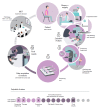Zebrafish Avatars towards Personalized Medicine-A Comparative Review between Avatar Models
- PMID: 31991800
- PMCID: PMC7072137
- DOI: 10.3390/cells9020293
Zebrafish Avatars towards Personalized Medicine-A Comparative Review between Avatar Models
Abstract
Cancer frequency and prevalence have been increasing in the past decades, with devastating impacts on patients and their families. Despite the great advances in targeted approaches, there is still a lack of methods to predict individual patient responses, and therefore treatments are tailored according to average response rates. "Omics" approaches are used for patient stratification and choice of therapeutic options towards a more precise medicine. These methods, however, do not consider all genetic and non-genetic dynamic interactions that occur upon drug treatment. Therefore, the need to directly challenge patient cells in a personalized manner remains. The present review addresses the state of the art of patient-derived invitro and invivo models, from organoids to mouse and zebrafish Avatars. The predictive power of each model based on the retrospective correlation with the patient clinical outcome will be considered. Finally, the review is focused on the emerging zebrafish Avatars and their unique characteristics allowing a fast analysis of local and systemic effects of drug treatments at the single-cell level. We also address the technical challenges that the field has yet to overcome.
Keywords: Avatars; PDX; cancer; personalized medicine; tumor microenvironment; zebrafish.
Conflict of interest statement
The authors declare no conflict of interest and nothing to disclose.
Figures






References
-
- El-Shami K., Nallapareddy S., Messersmith W. Early Diagnosis and Treatment of Cancer Series: Colorectal Cancer. WB Saunders; Philadelphia, PA, USA: 2011. Systemic therapy for colon cancer; pp. 167–183.
-
- Van Cutsem E., Cervantes A., Adam R., Sobrero A., Van Krieken J.H., Aderka D., Aranda Aguilar E., Bardelli A., Benson A., Bodoky G., et al. ESMO consensus guidelines for the management of patients with metastatic colorectal cancer. Ann. Oncol. 2016;27:1386–1422. doi: 10.1093/annonc/mdw235. - DOI - PubMed
Publication types
MeSH terms
LinkOut - more resources
Full Text Sources
Medical
Miscellaneous

